In the modern era, the cultivation of foreign talents extends beyond the traditional enhancement of humanistic knowledge, with literature playing a pivotal role. Addressing the challenges posed by the “golden curriculum,” this study uses the “Selected British and American Stories” program as an example to explore a blended learning and sorting approach. Aligned with the Ministry of Education’s emphasis on “golden subjects,” the research formulates an implementation strategy for curriculum development. In the context of the Ministry’s promotion of the mixed funding program in 2019, the study highlights the necessity of guiding students to utilize the Internet for data-driven blended learning. By emphasizing active engagement, intrinsic motivation, and flexible learning approaches, the proposed strategy aims to enhance teaching quality and align with contemporary educational reform priorities. Furthermore, the paper underscores the significance of equitable teaching evaluation as a feedback mechanism, actively contributing to the overall improvement of teaching quality.
A reform of higher education curriculum quality has been carried out comprehensively across universities and majors in China [10]. English and American (E&A) literature, as a core course for English majors, is facing the crisis of being marginalized and gradually declining [4,16]. In the context of pragmatism, universities in China have focused on offering language skills courses to strengthen students’ instrumental language training. However, the outdated teaching methods and content of E&A literature courses, coupled with the continuous reduction of credit hours for literature courses, have exacerbated the problem, especially in science and engineering institutions [14]. Addressing this issue, Professor Wang Shouren of Nanjing University firmly stated, “The question is not whether to offer E&A literature courses, but rather what to teach and how to teach it” [1]. Deepening the reform of the E&A literature teaching mode is essential for enhancing the construction of “golden courses.”
The National Standard for Teaching Quality of Foreign Languages and Literature (National Standard) issued in 2018 emphasizes that foreign language talents must possess both humanistic and scientific literacy [2]. It highlights the dual characteristics of humanism and instrumentality in foreign language education. English majors are required to understand that “its core is humanism and humanistic spirit devoted to the shaping of ideal personality, cultivating humanitarian spirit, and humanistic sentiment” [12]. Literature plays an irreplaceable role in achieving these goals, given its profound humanistic meaning and enlightening value.
First, literary reading and language learning are deeply intertwined. The Italian literary critic [13] suggested that one of the functions of literature is “to maintain the living state of language and make it our collective heritage.” Through intensive reading, imitation, and continuation of classic literature, students can greatly enhance their basic language skills, imagination, and creativity. Second, literature enriches the spiritual world. Confucius stated, “If you don’t learn poetry, you can’t speak” [15]. Solely pursuing the instrumental aspect of language learning while neglecting literary heritage leads to intellectual poverty and lack of expression. The Irish poet [20] argued that literature is “the great educational force of the world, the highest creator of all values.” In an age dominated by information explosion and materialistic desires, literature provides students with clarity and helps maintain noble character. Third, literature reflects the writer’s deep concern for the social realities of specific historical periods and vividly portrays unique life experiences. By expressing shared human emotions and aspirations, literary works evoke a sense of solidarity and connection among readers, fostering a sentiment of a shared human destiny [25,18].
Despite these values, E&A literature courses face challenges in aligning with the training requirements for English talents in the new era. First, the “higher-order” goals of the English major’s “golden course” necessitate students’ mastery of solid language skills, cross-cultural communication, and critical thinking. However, current teaching practices focus on exam preparation through rote memorization of terms, outlines, and “standard” interpretations, limiting students’ ability to engage critically with literary texts [6]. This approach keeps their cognitive engagement at a basic level, far from the advanced goals of analysis, evaluation, and innovation.
Second, the “innovation” aspect of the “golden course” requires contemporary, cutting-edge content, interactive teaching methods, and personalized learning outcomes [5]. Current practices rely on teachers’ lectures on literary history, representative writers, and their works, leaving students with limited exposure to complete literary texts. Consequently, students lack opportunities for independent interpretation and critical engagement.
Third, the “challenge” element of the “golden course” demands that the teaching content have sufficient depth and difficulty to stimulate critical thinking and discernment. However, many teachers rely on outdated textbooks and focus on easily testable content. Final assessments often involve closed-book exams, further encouraging rote memorization.
The reform of E&A literature courses is inevitable. Teachers must optimize teaching designs to transform E&A literature into a “golden course” that fosters cultural, critical, and innovative competencies, thereby restoring its value and significance within English major education.
According to Canadian scholar Garrison’s theory of presence, effective learning occurs only when all three types of presence—instructional presence, social presence, and cognitive presence—are at a high level [8]. Instructional presence refers to the “design, utilization, and management of cognitive and social processes of learning” [22], requiring teachers to carefully design, organize, and monitor instruction. Social presence emphasizes creating an open, friendly, and cooperative learning community where students engage in collaborative knowledge construction and critical thinking. Cognitive presence focuses on students’ ability to achieve meaningful knowledge construction by connecting new information to existing knowledge structures through inquiry, reflection, and critique. However, “online teaching leads to a natural lack of social presence and instructional presence due to the separation of time and space” [7], which in turn affects cognitive presence. This lack often results in poor online learning, low course completion rates, and reduced teaching quality. Implementing a blended teaching model that combines online and offline classes is essential to improving instructional and social presence, thereby fostering cognitive presence. A dynamic teaching evaluation and feedback mechanism is also crucial for achieving effective cognitive presence in blended E&A literature courses, ensuring continuous feedback and supervision throughout all stages of blended teaching.
First, hybrid instructional design is not merely about how to teach but about how to facilitate student learning [17]. Improving instructional presence requires teachers to move beyond traditional steps, methods, and evaluations of literature teaching. Instead, instruction should be designed to promote students’ learning autonomy through a well-structured teaching evaluation and feedback mechanism. Blended teaching relies heavily on students’ independent learning abilities and their readiness for self-study outside class, which necessitates teacher supervision and feedback. Poorly designed feedback mechanisms can hinder students’ independent learning and impede course progress. Conversely, well-designed feedback allows teachers to guide students effectively, ensuring they engage with learning resources before class, identify difficult content areas, and ask purposeful questions during classroom sessions [3]. This preparation enables students to participate confidently in seminars and other activities, resulting in better teaching outcomes [21]. A multi-dimensional, dynamic evaluation system—combining diagnostic, formative, and summative assessments and incorporating teacher evaluation, peer evaluation, and self-evaluation—is essential. Qualitative evaluations, such as assessing the collection and analysis of E&A literature knowledge, group cooperation effectiveness, and self-reflection, should complement quantitative evaluations like platform statistics, quiz results, and midterm and final grades. Monitoring students’ online learning processes—such as study duration, repeated study frequency, online assignment submissions, and participation in online discussions—helps create a continuous feedback loop. This loop enables teachers to adjust teaching plans, students to refine their learning strategies, and both to improve instructional and cognitive presence for better teaching effectiveness.
Second, information technology should be leveraged at all stages of blended teaching [19]. New information technologies can enhance evaluation and feedback systems, enabling accurate and immediate responses. Familiarity with technological learning environments is considered a crucial scaffold for creating social presence in the early stages of blended courses. Therefore, using software platforms or social media familiar to both teachers and students can reduce technological barriers in feedback and evaluation processes, enhancing students’ psychological comfort and self-efficacy in blended learning environments [24]. Moreover, blended learning processes should incorporate both synchronous and asynchronous online learning and communication. Synchronous channels provide opportunities for real-time guidance and feedback, creating a trusted and open learning environment conducive to collaborative and exploratory learning [23]. While asynchronous communication allows students ample time for reflection and comfortable knowledge construction, it can also lead to feelings of isolation and passive engagement [9]. Thus, incorporating synchronous learning opportunities alongside asynchronous activities ensures interactive and effective learning experiences, enhancing both social and cognitive presence [11].
Additionally, literature as a form of language and art has the unique ability to express emotions, impart knowledge, and resonate deeply with individuals. Different students may experience varied emotional and intellectual responses to literary works. To capitalize on this, blended teaching models should organize classroom explorations and cooperative activities, while also creating online synchronous learning groups. Using familiar tools such as WeChat or StudyTalk, teachers can open channels for collaborative learning and feedback. These platforms allow students to discuss course materials, share insights, and receive timely feedback from peers and instructors. Courseware, teaching videos, quizzes, and discussion forums can support students in independent learning, increasing the social immersion of online literature courses and improving learning outcomes.
Data mining is a process of retrieving valuable information hidden within large datasets using specific algorithms. Compared to other data analysis methods, data mining has a broader range of applications and can handle both structured and unstructured data, making it highly valuable. The specific data extraction process is illustrated in Figure 1.

The course “English and American Short Stories” is an elective for second-year English major students, spanning 16 teaching weeks, with 2 hours per week (32 hours in total). Based on this course, a hybrid online and offline approach is proposed to create a “golden course” for E&A literature.
Literature courses should transcend the mere accumulation of chronology, history, and works; they should avoid rote memorization as a primary learning method. Teaching E&A literature must return to reading literary classics, encouraging students to actively participate in constructing textual meaning and enhancing comprehension and appreciation. Hutchins emphasized the importance of reading classics, significantly influencing higher education in the U.S., while Bloom stressed that deep and sustained reading fosters self-knowledge. Reading literature allows students to engage in meaningful dialogue with texts, a process described as “discernment and re-creation.”
Teachers should consider students’ actual learning contexts, integrating multiple textbooks, online course resources, and other web-based materials to construct tailored teaching content. Presently, various E&A literature textbooks are available, and the Ministry of Education’s nine nationally recognized high-quality online courses provide a foundation for developing a hybrid “golden course.” Table 1 lists these courses.
Teachers should maintain a broad academic vision, using essential elements and common literary techniques of short stories as a framework. They should draw from multiple editions of textbooks and online learning platforms to select works by writers from diverse periods, countries, genders, and styles. This selection should include both classical and contemporary works. The chosen texts should be dynamically adjusted to reflect national developments and the latest research in E&A literature. Weekly, students must complete online learning tasks assigned by the instructor, engage in intensive reading of a short story, and conduct general reading of an extended novel.
| Serial No. | Course Name | Course Leader | Construction Unit | Platform | Year |
| 1 | Appreciation of Western Literature Classics | Liu Hongtao | Beijing Normal University | Chinese University MOOC | 2017 |
| 2 | History of Foreign Literature | Jiang Chengyong | Zhejiang University of Technology | Chinese University MOOC | 2017 |
| 3 | Appreciation of the Classics of World Chinese Literature | Zhao Xiaoqi | Wuhan University | Chinese University MOOC | 2017 |
| 4 | Literary Appreciation and Criticism | Chen Guoen | Wuhan University | Chinese University MOOC | 2017 |
| 5 | Comparative Literature | Hu Yamin | Huazhong Normal University | Chinese University MOOC | 2017 |
| 6 | Selections from Foreign Literary Classics and Realistic Perspectives | Zou Tao | University of Electronic Science and Technology | Chinese University MOOC | 2017 |
| 7 | Selected English and American Poetry | Huang Zongying | Beijing Union University | Chinese University MOOC | 2018 |
| 8 | English and American Poetry | Xue Jiabao | Yancheng Normal University | Chinese University MOOC | 2018 |
| 9 | EA Literature in the Perspective of Western Modernization | Li Chengjian | Southwest Jiaotong University | Chinese University MOOC | 2018 |
Before the class, the teacher should divide the students into several learning groups based on the principle of “homogeneity between groups and heterogeneity within groups,” with 3–4 students per group. In the first week, the teacher introduces the teaching model, clarifies the evaluation criteria to the students, teaches the knowledge points of the section, and assigns the corresponding post-lesson intensive reading, general reading, and online learning tasks for the next section.
Students, as the main learners, are required to work in small groups focusing on (but not limited to) the elements or literary techniques of the novel covered in the lesson. This is based on a close reading of the text, and they are expected to develop their understanding through independent interpretation, extensive literature review, and group discussions, culminating in the creation of a PPT.
Starting in the second week, the first five minutes of the first class period will be dedicated to students presenting the author of that week’s novel in small groups. Afterward, these groups will present their understanding of the novels read in the previous class using a PPT. The teacher will briefly summarize the group presentations in the second class period, guiding students to form more comprehensive and in-depth interpretations of the text. Additionally, the teacher will teach new knowledge points based on checking the pre-reading of online resources while assigning new close-reading and extended-reading tasks along with online learning content.
Usual grades can be categorized into attendance, online resource learning, group presentation, author introduction, class discussion, and other components. For activities reflecting discernment and “challenge,” such as group presentations and class discussions, their score weight can be increased. For lower-order and easy-to-complete tasks, such as attendance and online learning completion, their score weight can be reduced accordingly.
During group presentations, students should clearly indicate each member’s contributions on the PPT to ensure full participation and discourage “free-riding” behavior. The teacher monitors each student’s participation in class discussions, providing dynamic feedback and offering guidance and encouragement to less motivated students (see Figure 2).
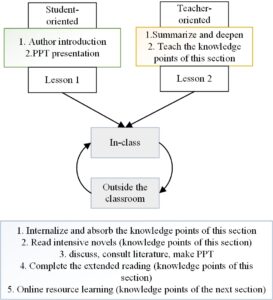
The final assessment can transition from a closed-book written exam to a course paper. Students will analyze selected short stories based on the basic standards of academic essay writing, integrating literary criticism theories and analytical methods they have learned, and referencing relevant literature. This method both evaluates students’ abilities to read, understand, and analyze novels and prepares them for advanced studies in E&A literature. Additionally, it introduces students to the process of writing literary criticism in a preliminary yet structured manner, building a foundation for future dissertation work.
The teacher should have a profound literary background and strong research capabilities, keeping up with academic advancements. They should integrate literary criticism theories and academic frontiers into teaching, explaining methods for appreciating literary works in an accessible and engaging way. Teachers should guide students in analyzing character development, thematic content, and stylistic elements of works, while summarizing literary history from representative works.
Teachers should encourage students to explore and critically examine universal issues reflected in literary works, using literature as a lens to reflect on contemporary society. This allows students to experience the real-world relevance of literature.
In practice, teachers should avoid one-sided teaching, instead guiding the interpretation and learning of textual meaning through questions that encourage depth and breadth. Multimedia resources, such as PPTs, photography, film clips, and songs, should be used to stimulate and enhance student participation. Teachers should also integrate Chinese elements into the study of E&A literature, drawing comparisons between Chinese and Western literature and culture. This approach encourages students to highlight Chinese wisdom on the global stage.
Furthermore, teachers should maintain control over the course rhythm, grasp the text’s connotations, and provide timely nudges and feedback when students’ interpretations deviate. This ensures students feel engaged and motivated to participate in classroom activities.
This teaching design employs advanced teaching concepts, utilizes high-quality teaching resources, and repositions the roles of teachers and students. It fosters active cognitive learning, enhances students’ sense of freedom and responsibility, and establishes an interactive learning model and multi-dimensional evaluation mechanism to enrich the teaching value of British and American literature courses.
The E&A literature course requires a high level of professionalism, language proficiency, and literature expertise, along with rich practical experience, communication, and coordination skills. Students need to understand E&A literature and related laws and regulations, master the operation of English literature work, provide accurate E&A literature information, and develop modern analytical methods and critical thinking skills in the field of economics and literature.
E&A literature, as a highly technical and practical discipline, demands professional vocational skills training through university education. One key method to cultivate applied talents is by improving students’ hands-on abilities and employability through experimental training courses and practical teaching. This approach bridges the gap between academia and the workplace, enabling students to transition seamlessly into professional roles.
The construction of a mobile learning website and APP platform for E&A literature courses promotes digital education and facilitates online learning and problem-solving. This enhances students’ initiative in learning. The mobile learning environment, with its strong scalability and openness, provides flexible and diverse learning scenarios. It transforms traditional, verification-based experimental training rooms into comprehensive and innovative spaces, breaks the time and space limitations of teaching, and creates a student-centered, independent mobile learning environment.
Through innovative labs and various E&A literature skill competitions, the second classroom is expanded to cultivate students’ research and innovative learning abilities. The integration of mobile learning with laboratory teaching and the strengthening of school-enterprise cooperation creates a new practical teaching system that combines “teaching, learning, and doing.” This approach builds a robust talent cultivation model, as illustrated in Figure 3.
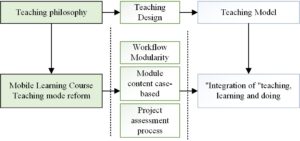
This model employs an innovative assessment method of “process + result,” leveraging advanced technology to monitor the learning process and assess students’ mastery of E&A literature skills. The assessment spans the entire learning process, promoting overall teaching activities and preventing individual students from becoming disengaged or opportunistic. This encourages all students to progress together.
Data mining technology is utilized to analyze educational resources and learning activities, track the implementation of talent training systems, improve the effectiveness of mobile learning, and dynamically optimize teaching resources. The model requires the establishment of a process measurement and regular tracking mechanism to evaluate the effects of course teaching, identify content design needs, and provide timely feedback on teaching methods and approaches.
By analyzing quality-influencing factors, the model identifies those with the greatest impact on practical teaching quality. Key research is then conducted on these factors to improve quality control in relevant teaching activities. Data mining technology enables efficient analysis and management of educational resources, allowing for the quick extraction of useful data for optimizing teaching methods and resources. This enhances students’ learning initiatives and lays a foundation for sustainable development.
The software system is used to monitor the implementation process, conduct real-time detection and analysis of key nodes in the learning process, and evaluate vocational skills and teaching outcomes. The results are used to dynamically optimize mobile learning education resources and management systems, as shown in Figure 4.
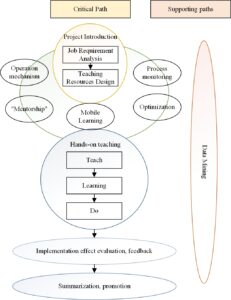
The data for this study mainly comes from a database of E&A literature grades. From a large amount of grade data, we selected four courses for 2015-level E&A literature students as the research objects. The data for these courses is shown in Table 2.
| Academic Number | EA Literature Reading | Fundamentals of English | EA Literature Writing | EA Literature Listening |
| 15050100101 | 78 | 85 | 69 | 79 |
| 15050100102 | 78 | 55 | 69 | 74 |
| 15050100103 | 61 | 56 | 74 | 92 |
| 15050100104 | 65 | 63 | 78 | 60 |
| 15050100105 | 88 | 97 | 96 | 99 |
| 15050100106 | 69 | 72 | 97 | 79 |
| 15050100107 | 55 | 76 | 68 | 60 |
| 15050100108 | 1 | 1 | 1 | 1 |
|
|
|
|
|
|
The student with the academic number “15050100108” was excluded from this study by ignoring the tuple because this student missed the exam. Since this study primarily focuses on analyzing the relationship between the excellent performances in various subjects, it requires logical data representation for correlation analysis. To achieve this, we converted student grades into a Boolean representation, as shown in Table 3.
| Academic Number | a1 | b1 | c1 | d1 |
| 15050100101 | 0 | 1 | 1 | 1 |
| 15050100102 | 1 | 0 | 1 | 1 |
| 15050100103 | 0 | 1 | 0 | 0 |
| 15050100104 | 0 | 1 | 0 | 0 |
| 15050100105 | 1 | 1 | 1 | 1 |
| 15050100106 | 0 | 1 | 0 | 1 |
| 15050100107 | 0 | 0 | 0 | 0 |
| 15050100108 | 1 | 1 | 1 | 1 |
|
|
|
|
|
|
In Table 3, the numbers “1” and “0” indicate the presence or absence of excellence in a particular course. The four courses mentioned above are key subjects in this E&A literature teaching reform, focusing on the integrated improvement of “teaching,” “learning,” and “doing.” The evaluation system for these courses has been optimized, and only when the total evaluation score for “teaching,” “learning,” and “doing” exceeds 80 points is the course considered excellent.
In the Boolean representation:
– The number “1” represents an excellent performance in the course.
– The number “0” represents the absence of an excellent performance.
For simplicity, the corresponding letters are used to represent the four courses:
– a1: English Linguistics
– b1: English Reading
– c1: English Translation
– d1: Reading of British and American Short Stories
Support and confidence are the two important factors in association
rule mining within data mining, and both are essential. To perform
association rule mining on the aforementioned achievement data, the
first step is to determine the support and confidence levels. Assume
that the minimum support and confidence are 33.3% and 60%, respectively.
There are 30 transactions in the database, i.e.,
According to the computational principle of the Apriori association
algorithm, all subsets of frequent itemsets involved in the computation
process should also be frequent. If a subset does not meet the frequency
requirement, it is removed from the set. For instance, when mining the
E&A literature student achievement data, the first two candidates in
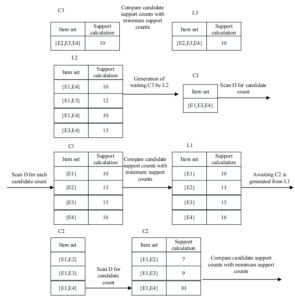
After computing the support, the next step is to calculate the confidence of each non-empty subset of the final frequent terms using the confidence formula. The calculations are as follows:
Since the minimum confidence is set to 60%, all the above results are valid. The resulting association rules are:
When
When
When
When
When
When
From the results of the study, it is evident that, among the four courses selected, except for the subject of English linguistics, there are inevitable connections among the other three courses. Each course grade influences the grades of the others to varying degrees. The data analysis reveals that English reading and English translation, as two essential professional and technical courses, greatly influence the specialized course of reading British and American short stories. Conversely, the influence of reading British and American short stories on English reading and translation is smaller. Hence, curriculum designers for E&A literature departments should prioritize English reading and translation as core courses, while offering reading British and American short stories as an optional course based on the needs of enterprises and employers.
After determining the reform strategy, it was implemented in practice. The recognition of the proposed strategy by teachers and students was investigated. The specific results are shown in Figure 6 and Figure 7, respectively.
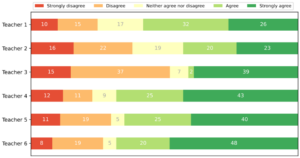
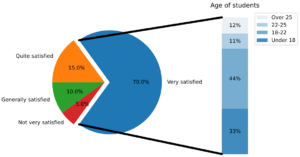
Figure 6 indicates that all surveyed teachers highly recognized the strategy. Figure 7 shows that up to 70% of students were very satisfied with the reform strategy, with the highest proportion of satisfaction observed among students aged 18–22.
Additionally, changes in students’ grades after implementing the reform strategy were analyzed. The results, as shown in Figure 8, reveal significant improvements in grades across different test units. Although the degree of improvement varied slightly, a noticeable enhancement in student performance was observed.
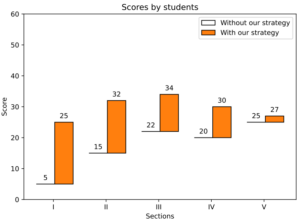
Under the guidance of the “Golden Course” standard and the cultivation requirements of the National Standard, this study highlights the necessity of the E&A literature course, analyzes the problems in the original teaching mode, and proposes practical curriculum reform strategies based on teaching practice. The study emphasizes the importance of aligning basic and specialized courses in the E&A literature curriculum system to form an integrated and coherent structure. These findings provide actionable insights for improving teaching quality and optimizing course offerings to meet professional demands.
This work supported by Southwest Jiaotong University Hope College School level Quality Engineering Project, Project Number 2024018.
1970-2025 CP (Manitoba, Canada) unless otherwise stated.